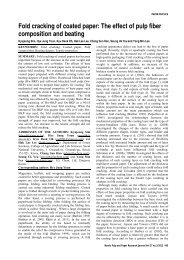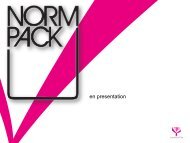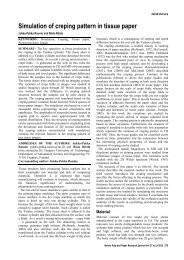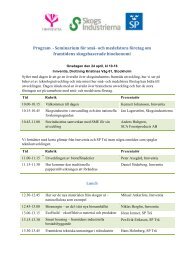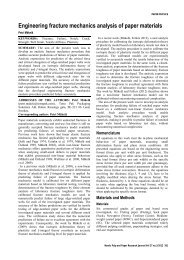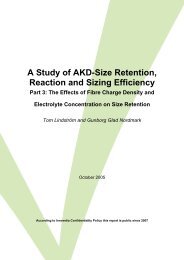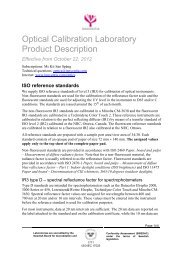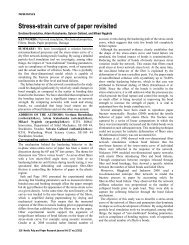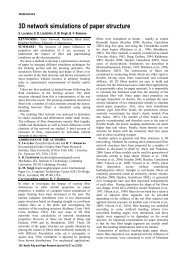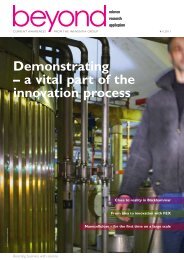HIERARCHIC DESIGN AND MATERIAL IDENTITY ... - Innventia.com
HIERARCHIC DESIGN AND MATERIAL IDENTITY ... - Innventia.com
HIERARCHIC DESIGN AND MATERIAL IDENTITY ... - Innventia.com
You also want an ePaper? Increase the reach of your titles
YUMPU automatically turns print PDFs into web optimized ePapers that Google loves.
COMPOSITES WEEK @ LEUVEN <strong>AND</strong> TEXCOMP-11 CONFERENCE. 16-20 SEPTEMBER 2013, LEUVEN<strong>HIERARCHIC</strong> <strong>DESIGN</strong> <strong>AND</strong> <strong>MATERIAL</strong> <strong>IDENTITY</strong>Siv Lindberg 1 *Ann-Sofie Hartzén 2,3 , Thomas Wodke 4 , Mikael Lindström 1,5*1 <strong>Innventia</strong> AB, Box 5604, SE-114 86 Stockholm, Sweden2 University of Gävle, Faculty of Engineering and Sustainable Development, Department ofBuilding, Energy and Environmental Engineering, Högskolan i Gävle, SE-801 76 Gävle,Sweden3 Systems and <strong>com</strong>ponent design, Machine design, KTH, SE-100 44 Stockholm, Sweden4 Fraunhofer-Institute for Environmental Safety and Engineering Technology UMSICHT,Osterfelder Straße 3 46047 Oberhausen, Germany5 Experience Design Group, Konstfack, University College of Arts, Crafts and Design,Lm Ericssons väg 14, SE- 126 26 Hägersten, Sweden*corresponding authors:siv.lindberg@innventia.<strong>com</strong> (material identity)mikael.lindstrom@innventia.<strong>com</strong> (hierarchical designABSTRACTOne of the keys to the <strong>com</strong>mercial success of new materials is according to research, that theyshould be introduced with unique aesthetic properties emphasizing that they are different tothe regular ones. Designing identity into new materials, by using a Hierarchic Design processto convey meaning to materials is the scope of our research on materials identity. TheHierarchical Design concept constitutes of design at three different levels: (i) <strong>com</strong>ponentdesign (materials’ <strong>com</strong>ponents), (ii) materials design or <strong>com</strong>posite design, and (iii) productdesign. Designing new materials using a Hierarchic Design process is to conveyfunctionality, meaning and identity to materials through multidisciplinary collaboration. Thisrequires an effective interface between scientists with different backgrounds such aschemistry, mechanical engineering, design and psychology.Our interviews with designers, informants and brand innovators show that there iswillingness and a strong interest from this group to work more closely with the materialsscientists, making it possible for them to influence the material’s physical qualities,expression and how it can be processed. In this way they can be sure to have a material thatfulfills the requirements in a design project. Two studies using the Product Semanticsmethodology to quantify the non-technical properties of bio-<strong>com</strong>posites in the context of othermaterials reveal two main principal <strong>com</strong>ponents in both cases; the 1 st is related to the qualityand value, and the 2 nd <strong>com</strong>ponent relates to naturalness and environmental friendliness. Thisindicates that materials perceived to be high in naturalness and environmental friendlinesswas not rated high on quality attributes and vice versa. These results demonstrate a challengeat the material/<strong>com</strong>posite design level; which strategies to develop in order to design thesenew materials to express e.g. a high degree of naturalness without <strong>com</strong>promising theimpression of quality?INTRODUCTIONTraditionally materials development has been driven by two different driving forces, seefigure 1. The development within aerospace, medicine and military has demanded newmaterials in order to over<strong>com</strong>e technological problems, to find e.g. super light materials,
COMPOSITES WEEK @ LEUVEN <strong>AND</strong> TEXCOMP-11 CONFERENCE. 16-20 SEPTEMBER 2013, LEUVENmaterials <strong>com</strong>patible with the human body or materials that will be transparent to radiation ofcertain wavelengths. Money has not been a limitation; there has been a need for smallvolumes of very special materials that can solve a given problem. Over time some of thesematerials have turned into <strong>com</strong>modities and be<strong>com</strong>e available in larger volumes at reasonableprices, i.e. Teflon® and super alloys. The second big driving force has been to find cheaperhigh volume solutions for the manufacturing industry. In order to maintain the profit marginson a tougher market, new and cheaper material solutions have been needed. These materialscan be seen as substitutes, they are developed to substitute materials that already exist, andthey usually have to fit in the existing production processes in order to be <strong>com</strong>petitive pricewise. They have to be cheaper and better performing in order to take market shares. Forestbased renewable <strong>com</strong>posites have traditionally been viewed as sustainable replacements forexisting oil-based materials.Figure 1. The relation between price and volume for <strong>com</strong>mercial materials.(1) New materials are expensive butonce the volume gets big and patents expire, the price will fall. The figure also demonstrates the two drivingforces in materials development; the development of technology driven high tech materials and the search forcheaper <strong>com</strong>modity materials. Drawing Farvash Razavi and Nandi Nobell.The fear of an oil shortage and the global warming discussion have introduced a third drivingforce in the development of new materials; the bio based, low carbon foot print materials thatcan save humanity from peak oil and the global warming crisis. A major question connectedto the bio based driving force is: How do we introduce new materials on the market?<strong>HIERARCHIC</strong> <strong>DESIGN</strong>We introduced the R&D&D concept (Research & Design & Development) in which we aimto develop a <strong>com</strong>posite material concept that will allow for tailor made materials for specificapplications [1]. A <strong>com</strong>posite material consists of different <strong>com</strong>ponents, fibres, polymers,plasticisers, binders, fillers, pigments, and different modifiers like anti-oxidants and fireretardants. The structure in the material will define the material properties. Relevant materialproperties can be tailored by designing the <strong>com</strong>ponents, the <strong>com</strong>position of <strong>com</strong>ponents andthe product property requirements. We call our approach Hierarchic Design and define threedifferent levels of design:
COMPOSITES WEEK @ LEUVEN <strong>AND</strong> TEXCOMP-11 CONFERENCE. 16-20 SEPTEMBER 2013, LEUVENComponent design. On this level we study and develop different <strong>com</strong>ponents, polymers,<strong>com</strong>patilisers and reinforcement of fibres. At this level the fibre is designed. Contrary to welldefinedman-made fibres like carbon fibre or glass fibre where the mechanical properties canbe found in a hand book, bio based cellulose fibres have a wide spectrum of properties.Depending on which specie the fibre is extracted from and where it has been growing, when ithas been harvested, and how it has been processed, the fibres will have different properties. Inaddition, the fibre wall as well as the fibre surface can be modified and tailored to have givenchemical and structural features.Material design. This is the level where the material is given its final structure. On this levelwe decide which <strong>com</strong>ponents to blend and in what proportions. Should the fibres be randomlyoriented or parallel? Should the fibres be un-bleached or bleached? From which plant speciesshould they be derived? Surface modified or with a cross-linked fibre wall? What polymershould be chosen and which production process? Hot pressing, moulding or injectionmoulding will give very different structures.Product design. The product design will define the material properties needed in anoptimised design. The designer and the production engineers will give the product andprocess restrictions and hence define the material structure. The material structure can then becalculated from the models developed at the other levels and the right <strong>com</strong>bination of<strong>com</strong>ponents and production processes can be chosen.Hierarchic Design is a process in which materials scientists and designers need to<strong>com</strong>municate material-selection based information, e.g. measurable technical characteristicsof materials and material-perception based information, e.g. sensory perception, emotions andexperience. The new forest based renewable <strong>com</strong>posites should not only fulfil technicalrequirements, they should also appeal to users’ senses and render an intended meaning toproducts. Designing new materials by using a Hierarchic Design process is to conveyfunctionality, meaning and identity to materials through multidisciplinary collaboration whichin turns requires an effective interface between scientists with different backgrounds such aschemistry, mechanical engineering, design and psychology.CASE STUDY: DRIVERS FOR USING NEW <strong>MATERIAL</strong>S IN <strong>DESIGN</strong>The new materials face a challenge in that they are generally unknown to the consumermarket. What makes the designer select a new material, e.g. a new bio <strong>com</strong>posite for a designproject? As part of the research project – The Materials Statement, we have performedinterviews with designers, brand innovators and material informants to find out why theywant to use a new material in a project, their opinion on how identity is formed in a newmaterial and what the opportunities and difficulties are with choosing a new material. Theinterviews were done in a semi structured form, with a numbers of questions that the subjectcould answer freely to.The preliminary results (table 1) indicate a will and a strong interest from the designers towork more closely with the materials scientists. This makes it possible for them to be firstwith a new material and to through design influence how the new material will be perceivedon the market. Through the cooperation with materials scientists they can influence how thematerial is designed and processed in order to express certain physical properties. In this waythey can be sure to have a material that fulfills the requirements in a design project. They alsoindicate the importance of using the material in the right product so that the material’squalities are enhanced.
COMPOSITES WEEK @ LEUVEN <strong>AND</strong> TEXCOMP-11 CONFERENCE. 16-20 SEPTEMBER 2013, LEUVENTable 1 Drivers for selecting new materials in product design and actions taken to create meaning and identityfor new materials. Results from interviews with designers, brand innovators and material informants.Question Drivers Results from interviewsReasons forselecting anew material for adesign projects.How to createpersonality andidentity to newmaterials.Newness as aqualityInfluenceEnvironmentalinterestNew functionsor qualitiesNeedsHands-onDisplaymaterial inproductsMarketingTo be first with a new material is something that increases the brandvalue for product <strong>com</strong>panies. On a <strong>com</strong>petitive market there is alwaysa need to stay ahead of the <strong>com</strong>petition and have products that arebeing viewed as the latest in design. One of the most <strong>com</strong>monquestions posed to the material informants from designers andarchitects concerns what new materials they have on display.Being the first designer to work with a material gives the possibility toinfluence how a material will be perceived and thus create itspersonality and value on the market. The lure of doing something new,and going down a new path is strong. Also working directly with thematerials scientists and having the possibility to be involved in thecreation of the material; its behaviour and expression, and to see itspotential in product design is attractive to some designersA strong interest in environmental issues and sustainability issomething that several designers express. They want to find newmaterials that have less impact on the environment than existing ones.This can also be a driving force for working with materials scientists assome of the designers express that there is a lack of environmentalfriendly materials on the market. They have a desire to contribute to thedevelopment of more sustainable materials.To find a material that has a new function or quality that can deliversomething new to the product. It can be a surface, how the materialfeels to the touch or its appearance. It can also be the ability to use anew production method when choosing this material.In some design projects, designers experience needs that cannot befulfilled with the materials that are on the market today. This creates ademand for new materials that have specific functions or expressions.This can also be a driving force to work directly with the materialsscientist, being able to develop a material with the desired qualities.Try the material to get information on its performance, feeling, andappearance, the processing possibilities and limitations in order to findthe materials unique qualities. The designer often wants to collaboratewith the materials scientists in order to gain their knowledge about thematerial and have the opportunity to suggest changes to the material. Ifpossible the designers prefer to work in a team with the scientists to beable to influence the materials functions, expressions and how it can beprocessed.Displaying the material in a product or demonstrator that enhances thematerial. It could be a specific function, a physical property or anexpression that should be <strong>com</strong>municated. For example, if a material’ssustainable quality is to be shown it is important that the product itselfis sustainable in production, use and waste. Otherwise there will be adiscrepancy between the material statement and the product. If thematerial is used in the right type of product it should add somethingnew to the product like a new expression or a new function.An important tool to <strong>com</strong>municate the material identity. A new materialneeds to be explained to the material buyers and consumers.Demonstrators or products can be used for this purpose in <strong>com</strong>binationwith other marketing channels like home pages, ads, etc. Some of thedesigners suggest using storytelling as a marketing method. The storybehind the material, the materials’ lifecycle from origin to recycle, canbe used to <strong>com</strong>municate the materials unique qualities. Self-confidenceis mentioned as important when <strong>com</strong>municating the material identity;the way a material is launched plays a large part in how it will beperceived and therefore how the materials’ identity will be formed.
COMPOSITES WEEK @ LEUVEN <strong>AND</strong> TEXCOMP-11 CONFERENCE. 16-20 SEPTEMBER 2013, LEUVEN<strong>MATERIAL</strong> PERCEPTION <strong>AND</strong> <strong>IDENTITY</strong>Material perception is concerned with how we perceive what things are made of. Theperception of material properties can involve all of our senses; steel has certain gloss, feelssmooth and cold, and makes a certain sound when hit with a metallic object. Wood feelswarm, rougher than steel, have certain colours and textures and by knocking on e.g. a woodenwall, we can determine whether it is solid. The advent of <strong>com</strong>puter graphics and robot visionhas advanced our knowledge on how humans infer material properties through the visualsystem based on how light is reflected from the surface [2].Product semantics was defined by Krippendorff and Butter as “a vocabulary and methodologyfor designing artefacts in view of the meanings they could acquire for their users and the<strong>com</strong>munities of their stakeholders” [3]. Petiot [4] defined product semantics as the “study ofthe symbolic qualities of man-made forms in the context of their use, and application of thisknowledge to industrial design”. Kansei Engineering [5] is a methodology for translatingemotional and sensory responses to product design parameters. Design alternatives are ratedon adjective scales (e.g. strong, rough, natural, quality etc.).A CASE STUDY: THE <strong>IDENTITY</strong> OF NEW BIO-PLASTIC COMPOSITESA product semantic approach was adopted to investigate the semantic space of differentmaterials. Sixty (30+30) participants evaluated wood fibre-reinforced polypropylene (PP) orpolylactide (PLA) <strong>com</strong>posites, together with <strong>com</strong>mon materials, i.e. metals, wood andplastics. The descriptive words used in the study are in part based on previous elicitationstudies [6, 7] and on workshops with designers and materials scientists. In a first step, 7injection moulded wood fibre reinforced PLA <strong>com</strong>posites were evaluated with 4 metals, 5wood and fibreboard samples and 3 petroleum based plastic (PP) <strong>com</strong>posites. Subsequentprincipal <strong>com</strong>ponent analysis was used to reduce the semantic space to a smaller set offactors.Figure 1 Example of wood fibre-reinforced polypropylene or polylactide <strong>com</strong>posites used in the project.A principal <strong>com</strong>ponent analysis yielded two factors based on the criterion that the eigenvalueshould exceed 1. Together, the two factors explained 82 % of the total variance. All variablespresent <strong>com</strong>munalities of over 0.5. The first factor involves high loadings on qualityexclusive, exciting and beautiful, and high opposite loadings on cheap; whereas factor 2reflects the attributes natural and environmental friendliness. We named factor 1, Quality andValue; and Factor 2, Naturalness and Environmental friendliness, see figure 2. Quality andnaturalness/environmental friendliness are represented by two orthogonal factors meaningthat they have no correlation. The Naturalness factor is represented by the wood and wood
COMPOSITES WEEK @ LEUVEN <strong>AND</strong> TEXCOMP-11 CONFERENCE. 16-20 SEPTEMBER 2013, LEUVENfibre samples whereas the Quality factor is represented by the metals. The wood plastic<strong>com</strong>posites (PLA and PP) represent the opposite to wood on the naturalness.Figure 2 PCA of attributes in a 2-D solution for 21 materials. Semantic attributes are shown as blue vectors andmaterials as supplementary variables whose projection on the 2 factor solution are shown as red squares.Figure 3 PCA of attributes in a 2-D solution for 18 wood plastic <strong>com</strong>posites or different colours and<strong>com</strong>positions. Semantic attributes are shown as blue vectors and materials as supplementary variables whoseprojection on the 2 factor solution are shown as red squares.
COMPOSITES WEEK @ LEUVEN <strong>AND</strong> TEXCOMP-11 CONFERENCE. 16-20 SEPTEMBER 2013, LEUVENIn order to investigate the impact of different strategies at the material design level, the sameProduct Semantic methodology was adopted to 18 wood fibre-reinforced plastics. Fibre typeand amount, type of plastic (PLA or PP), colouring (dyed fibres and/or plastic). A principal<strong>com</strong>ponent analysis yielded a very similar factor structure as in the case with differentmaterials and the factors were again interpreted to be related to Quality and Value (factor 1);Naturalness and Environmental friendliness (factor 2), see figure 3. Again, material sampleperceived to be high in naturalness and environmental friendliness was not rated high onquality attributes. In this case, colour appears to be the most determinant property for theimpression of naturalness or value. White coloured and uncoloured samples were to a largerextent related to the Naturalness factor (factor 2) whereas in particular blue samples wererelated to the Value factor (factor 1).The results are in accordance with Karana [8], who found natural colours (mostly brownish)to be an important determinant in the expression of naturalness together with visible grainsand fibres, and a rougher surface. High quality materials were related to smooth surfaces,glossy and reflective.Our results demonstrate a challenge for the material design level; which strategies to developin order to design these new materials to e.g. increase the express ofnaturalness/environmental friendliness without <strong>com</strong>promising the impression of quality. Ongoingwork within this project concerns sensory analysis (visual and tactile exploration) ofdifferent material <strong>com</strong>positions in relation to material properties (e.g. surface chemistry,topography, texture, friction, gloss, colour, and optical homogeneity). Models based onsensory perception coupled with the structure of emotional responses will permit a mappingprocess from perceptual words to material design elements using techniques such as KanseiEngineering.CONCLUSIONSIn this paper we have presented a concept for developing new bio based materials that we callHierarchic Design, consisting of three different levels of design. The <strong>com</strong>ponent level iswhere the different <strong>com</strong>ponents of a material are studied and developed. The material designlevel is where the material is given its final structure depending on the desired properties ofthe material. The product design level is where the products requirements, regarding use,expression and production, define what structure the material should have.By involving the designers already at the material design level it is possible to moreaccurately tailor a material to a specific product or market segment. The scientist hasknowledge about the materials’ technical qualities, and the designer has knowledge about theusers’ need and wants. These requirements cannot be fulfilled solely by a materials physicalqualities but also involve the materials expression, the sensory perception of the material andthe emotions and experiences the user gets from the material, in order for the product toexpresses the intended meaning.Results from interviews with designers and brand innovators show that there is both a will andan strong interest from the designers to work more closely to the materials scientist, making itpossible for them to influence the material’s physical qualities, expression and processingtechniques. This way they can be sure to have a material that fulfils the needs in a designproject. They also indicate the importance of placing the material in the right type of productso that the material’s qualities are enhanced.
COMPOSITES WEEK @ LEUVEN <strong>AND</strong> TEXCOMP-11 CONFERENCE. 16-20 SEPTEMBER 2013, LEUVENBy studying how sensory and aesthetic dimensions of a material is related to its technicalproperties it is possible for the materials scientist and the designers to work together to createnew bio based materials that appeal to the users and will succeed on the market.Our results from perceptual evaluations of different materials demonstrate a challenge for thematerial design level in that quality/value and naturalness/environmental friendliness appearto be two separate and uncorrelated dimensions of materials perception. Which strategiesshould the materials scientist adopt in order to design these new materials to express e.g. ahigh degree of naturalness without <strong>com</strong>promising the quality impression?ACKNOWLEDGEMENTThis research was financed by grants from VINNOVA as a part of ERA-NET“WoodWisdom-Net2 – Networking and Integration of National Programmes in the Area ofWood Material Science and Engineering in the Forest Based Value Chains”, and from BoRydin Foundation.REFERENCES1. Lindström, M., Gamstedt, E. K., Berthold, F., Varna, J., & Wickholm, K., Hierarchical design as a toolin development of wood-based <strong>com</strong>posite applications, in 13th European Conference of CompositeMaterials, L.E. Asp and E.K. Gamstedt, Editors. 2008: Stockholm.2. Adelson, E.H. On seeing stuff: the perception of materials by humans and machines. in SPIE. 2001.3. Krippendorff, K. and B. Butter, Product semantics: Exploring the symbolic qualities of form inInnovation. The Journal of the Industrial Designers Society of America, 1984. 3(2): p. 4.4. Petiot, J.-F. and B. Yannou, Measuring consumer perceptions for a better <strong>com</strong>prehension, specificationand assessment of product semantics. International Journal of Industrial Ergonomics, 2004. 33(6): p.507-525.5. Nagamachi, M., Kansei Engineering: A new ergonomic consumer-oriented technology for productdevelopment. International Journal of Industrial Ergonomics,, 1995. 15: p. 3-11.6. Jonsson, O., Lindberg, S., Roos, A., Hugosson, M., & Lindström, M., Consumer perceptions andpreferences on solid wood, wood-based panels and <strong>com</strong>posites – A repertory grid study. Wood andFiber Science, 2008. 40(4): p. 663-678.7. Nyrud, A.Q., A. Roos, and M. Rødbotten, Product attributes affecting consumer preference forresidential deck materials. . Canadian Journal of Forest Research, 2008. 38: p. 1385-1396.8. Karana, E., Characterization of ‘natural’ and ‘high-quality’ materials to improve perception of bioplastics.Journal of Cleaner Production, 2012. 37(0): p. 316-325.




